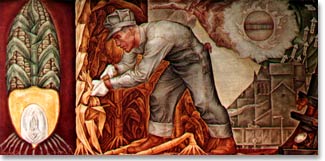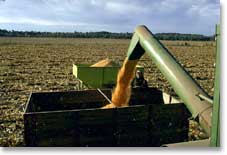
When Columbus "discovered" America, there was no corn on board the Nina, Pinta or Santa Maria. Before 1492, no one living in Europe ate corn cakes, corn bread or corn pudding. They didn't know corn existed.
Up to this time, corn grew only in the Americas. Scientists believe corn was originally cultivated by Indians in the highlands of Mexico thousands of years ago. The Indians discovered that corn was good to eat and very nutritious.

As Indian groups migrated north they brought corn with them. American Indians were growing corn in many parts of North America long before the first arrival of European explorers and traders.
Christopher Columbus and the explorers that followed him took corn back to Europe and introduced it to the world. Native American Indians taught European colonists to grow many varieties of the corn including yellow, red, blue, pink, and black kernels, often banded, spotted, or striped.
In the 1600s, early English settlers found the Indians of present-day northeastern United States growing a hard flint variety of corn that matured early.
Other English colonists who settled farther south found the Indians growing a soft-kernelled late-maturing dent corn. As time went on, the new settlers to America began to depend on corn as one of the most important farm crops.

American farmers have always wanted to grow strong healthy corn plants that yield as much as possible. In the later 1800s scientists worked on the development of hybrid corn. This research led to better varieties of corn and higher yields.
An Iowan named Henry A. Wallace developed an early variety of hybrid corn based upon his own scientific research. In 1926, he organized a seed company that is still known today as the Pioneer Hi-Bred International, Inc.
The number of farmers that used hybrid corn continued to increase through out the 20th century. As more farmers used hybrid corn, more corn was produced. In 1933 the average yield was 33 bushels per acres. In 1997 the yield had increased to 127 bushels per acre.

Corn is good for feeding hogs, cattle and other livestock, and many other products are made from corn too. In 1900, the main corn product was starch.
Today, thousands of uses for corn products have been discovered, and more uses are being found each day. Every part of the kernel and even the water in which it is processed are used.

Did you know that corn is used to help produce antibiotics, baby foods, condensed milk, some fruit juices and even peanut butter? On your lunchroom tray, how many foods might you identify that contain corn products? Where Does America's (Iowa's) Corn Go?

Copyright © 2022 CampSilos | All Rights Reserved
National Standards | Silos & Smokestacks | Credits | Awards
Crafted by IFC Studios, a midwest Branding Agency.